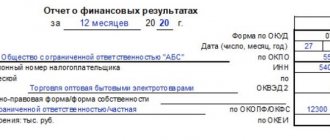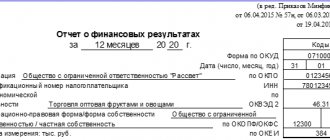Average profitability by industry allows you to evaluate the profitability of a particular industry - if you are going to open a business or invest in someone else's business, these statistics will be incredibly useful to you. For example, the top profitable industries for trade (by type of economic activity) for January-September 2017:
| Trade industry | Profit percentage, median |
| Machines for processing various materials | 191 |
| Watches and jewelry | 45 |
| Jewelry | 45 |
| Computers | 41 |
| Office equipment | 40 |
| Peripherals and software | 37 |
| Construction Materials | 29 |
| Confectionery | 29 |
| Second hand shops | 29 |
| Meat | 27 |
| Bread | 27 |
Infographics:
As the table shows, it is better to invest in the wholesale trade of processing machines - from 1 invested ruble you will receive 1.91.
Note that Rosstat has been collecting average profitability indicators since 2022, so the values in the article will be provided for the period 2017-2019 – there is simply no data for 2022. In theory, average return on sales and return on assets will be updated in mid-2022, but in practice, new data should be expected by the beginning of 2022.
Profitability by industry in Russia
Average profitability
Data on average profitability from 1995 to 2022 look like this (generated on the basis of financial statements, arithmetic average for all enterprises, small businesses excluded):
| Return on assets, % | Profitability of goods, products, works, services sold, % | |
| 1995 | 5.3 | 15.8 |
| 1996 | 1.3 | 4.8 |
| 1997 | 1.7 | 6.3 |
| 1998 | -0.9 | 8.1 |
| 1999 | 5.0 | 18.5 |
| 2000 | 7.6 | 18.9 |
| 2001 | 6.1 | 14.4 |
| 2002 | 4.3 | 10.9 |
| 2003 | 5.9 | 10.2 |
| 2004 | 8.5 | 13.2 |
| 2005 | 8.8 | 13.5 |
| 2006 | 12.2 | 13.2 |
| 2007 | 10.4 | 13.1 |
| 2008 | 5.4 | 13.0 |
| 2009 | 5.5 | 10.8 |
| 2010 | 6.7 | 10.0 |
| 2011 | 6.5 | 9.6 |
| 2012 | 6.1 | 8.6 |
| 2013 | 4.5 | 7.0 |
| 2014 | 2.5 | 7.3 |
| 2015 | 3.7 | 8.1 |
| 2016 | 5.9 | 7.6 |
| 2017 | 3.8 | 6.7 |
| 2018 | 4.7 | 10.7 |
| 2019 | 6.8 | 11.4 |
Data on the chart (red – assets, green – sales):
There is nothing unusual in such a distribution - sales, as current assets, should have greater profitability. But we note that these statistics are not very useful for a specific legal entity - the averaging method turns the average profitability into a “hospital temperature.”
Profitability by year
List of profitability percentages by year and industry:
| 2018 | 2019 | |
| Total | 10,7 | 10,8 |
| Housekeeping | 17,8 | 17,2 |
| Mining | 31,4 | 28,0 |
| Manufacturing | 12,0 | 11,5 |
| Printing | 12,3 | 11,8 |
| production… | ||
| ... coke and petroleum products | 8,8 | 9,7 |
| ...chemical | 25,2 | 22,1 |
| ...medicines | 21,6 | 26,6 |
| ... plastic or rubber products | 7,4 | 8,0 |
| ...non-metallic mineral products | 11,1 | 10,5 |
| ... metallurgical | 25,8 | 21,6 |
| ... computers | 12,0 | 13,3 |
| ... electrical equipment | 8,2 | 7,7 |
| ... automated technology | 3,2 | 6,1 |
| ... cars | 2,3 | 1,9 |
| ... other vehicles | 10,9 | 8,8 |
| ...furniture | 4,9 | 4,6 |
| Electricity, gas, steam, air conditioning | 8,5 | 8,9 |
| Construction | 3,9 | 4,5 |
| Trade | 5,1 | 5,2 |
| Transportation and storage | 8,4 | 7,8 |
| Mail, couriers | 3,0 | 2,0 |
| Hotels, catering | 5,4 | 2,7 |
| Information and communication | 11,7 | 11,9 |
| Finance and insurance | 17,7 | 34,0 |
| Real estate transactions | 18,0 | 18,1 |
| Scientific activity | 12,5 | 13,2 |
| Administrative activities | 15,7 | 40,7 |
| Education | 2,8 | 3,3 |
| Healthcare, social services | 7,0 | 7,4 |
| Sports, recreation, entertainment | -13,2 | -6,1 |
Interestingly, back in 2018-2019, sports, recreation and entertainment showed negative profitability. Most likely, in 2022 the rating of this industry has gone into deep minus.
Profitability by city
Alas, neither Rosstat nor the Federal Statistics service collect data on cities/regions.
Official figures
It is necessary to consider official indicators taking into account industry, regional and time factors.
Revenue and EBITda margin (earnings before interest and taxes), which actually reflects the amount of profit from sales before interest and taxes in each ruble, varied as follows from 2012 to 2015:
- 2012 – 1.8 billion rubles. industry average.
- In 2013 – 4.8 billion.
- In 2014 – 4 billion.
- And in 2015 about 8 billion.
By industry
Considering the level of profitability in various industries and activities in Russia, in accordance with the data sources used by Rosstat, here are the parameters and ratios that were demonstrated for 2015-2016:
- Communications and other services showed a negative trend of approximately -8%.
- Governance and state security were also in the red with Fr.
- Financial activities showed an insignificant increase of 0.2%.
- Hotels and restaurants increased the figure by 1.7%.
- Construction is about 3% in the black.
- Education is about 4% in positive dynamics.
- Wholesale and retail trade is just over +6%.
- Health care, pharmaceuticals and social services grew slightly more than 7%.
- Electricity and supply, as well as gas by 8%.
- Positive dynamics were also noted in the real estate and rental markets. Here the figure was more than 10%.
- Transport and communications were also in positive territory with a mark of 10.9%.
- Positive growth was also demonstrated by manufacturing industries – an increase of up to 11%.
- Oddly enough, agriculture and forestry showed a positive trend of 19%.
- Mining showed a profitability of 20%.
- But fishing and fish farming are in the black by almost 80%.
By region
As for regional indicators, here is what the statistics look like:
- Yakutia is in the black by 46.08%.
- Chukotka Autonomous Okrug, Murmansk Region, Kalmykia and Sakhalin are increasing production costs in the range from 30% to 40%.
- Nenets Autonomous Okrug, Krasnoyarsk Territory, Tyva, Kamchatka Territory, Magadan Region, Yamalo-Nenets Autonomous Okrug, Irkutsk Region - more than 20%
- Orenburg, Tyumen, Vologda, Kursk, Leningrad, Lipetsk, Belgorod, Chelyabinsk, Amur, Novgorod, Samara, Tula, Kemerovo, Arkhangelsk, Ryazan, Orel, Vladimir, Sverdlovsk regions, Khanty-Mansi Autonomous Okrug, Perm Territory, Buryatia, Karelia, Udmurtia , Tatarstan, Trans-Baikal Territory, Khakassia, Primorsky Territory - in the range from 10% to 20%.
- Tambov, Omsk, Krasnodar Territory, Bashkortostan, Bryansk - from 9% to 10%
- Bryansk, Kostroma, Komi Republic, Yaroslavl, Stavropol Territories - average profitability at 9%.
- Khabarovsk Territory, Chuvashia, Astrakhan, Tomsk regions - 8%.
- Sevastopol, Saratov, Penza, Voronezh, Kaliningrad, Volgograd, Rostov regions and Mari El - 7%.
- Altai Territory, Kirov, Nizhny Novgorod, Moscow, Kurgan regions and Karachay-Cherkessia - 6%.
- Smolensk, Novosibirsk, Ulyanovsk regions, as well as Adygea, Mordovia and St. Petersburg - 5%.
- Moscow and Pskov regions – 4%.
- Tver, Ivanovo, Kaluga regions - 3%.
- North Ossetia, Crimea, Kabardino-Balkaria – 2%.
- Dagestan and the Altai Republic were in the red with an average of -0.3%.
- Even lower figures are in Chechnya, Ingushetia and the Jewish Autonomous Region, where negative balances range from -5 to almost -9%.
On years
Assessing the dynamics of the financial results of the entire set of organizations that operated on the territory of the Russian Federation in a certain period of time, here are some general indicators that can be cited:
- In 1995, the share of profitable organizations was 65.8%.
- In 2000 – 60.2%.
- In 2005 – 63.6%.
- In 2010 – 70.1%.
- In 2015 – 67.4%.
- In 2016 – 70.5%.
- 2017 showed a mark of 68.1%.
- 2018 increased the figure to 72.6%.
If we consider the balance of profits and losses of an organization without small businesses in the Russian Federation, then here are the indicators by type in billions of rubles given by the Federal Statistics Service:
- 2005 – 1350 rub.
- 2006 – 1420 rub.
- 2007 – 1750 rub.
- 2008 – 620 rub.
- 2009 – 1600 rub.
- 2010 – 1800 rub.
- 2012 – 1900 rub.
- 2014 about 2200 rub.
- 2016 about 5500 rub.
- 2017 about 6000 rub.
- 2018 about 13,500 rub.
Norms
From the perspective of the enterprise’s functioning, a level of profitability that takes into account:
- The total burden of income taxes.
- VAT accounting.
Thus, for the manufacturing sector, 3% is considered low. For trade enterprises, the unsatisfactory level is 1%.
How to calculate profitability level
It is important to differentiate the profitability indicator from revenue.
If revenue simply reflects the company’s total turnover (it is calculated in rubles), then profitability is the efficiency of its activities (expressed in %). Any business that has brought profit at the end of the period under review can be called profitable. If a loss is made, the profitability will be negative. In trading activities, the profitability of a product is calculated as the ratio of net profit to cost.
Profitability of goods (services) = net profit from sales (provision of services) / cost * 100%. Return on sales (services) = net profit/revenue*100%.
Let's say a company sells women's clothing.
She purchased goods worth 12 million rubles and sold them for 28 million rubles. At the same time, administrative and commercial expenses amounted to 5 million rubles. Thus, the profit amounted to 11 million rubles, and the profitability of goods was 11/12 * 100 = 91%. The profitability of services is calculated in a similar way; in this case, the cost does not take into account the purchase price of the goods, but, for example, the costs of purchasing tools, paying workers, etc. In assessing the profitability of sales, the net profit and turnover of the company are taken into account. If we take the example of a clothing store as a basis, it will be equal to = 11/28*100%= 39.2%. Using this formula, it is advisable to evaluate each product group separately. For example, the profitability of sales of T-shirts, sneakers, bags, etc. This will allow you to highlight the most effective items in the assortment, as well as those that need to be worked on increasing their profitability.
Profitable industries
Against the backdrop of the global commodity rally, the mining industry demonstrated the greatest profitability: resource enterprises in January-September 2022 received a profit of 13.1% of their assets. This is a key sector for the Russian economy, whose financial results are in line with the average for all other industries.
The second and third places in terms of profitability were taken by the healthcare and social services sector (9.3%; excluding state medical institutions), as well as administrative activities (8.6%; this includes equipment rental, building maintenance, security, business support for enterprises , activities of call centers, disinfection and other support services for business). They occupy a small share in the economy compared to the real sector, and at the same time they have a lower capital intensity, unlike heavy industry, that is, they require less investment.
The fourth place in terms of profitability is occupied by the manufacturing industry (8.2%), the largest macro-industry in terms of absolute profit, the lion's share of which is tied to raw materials. This is followed by wholesale and retail trade (profitability 7.5%) and agriculture (7.4%).
The lowest profits relative to the value of assets were obtained by the real estate business (purchase, sale, rental, management), where the profitability was only 0.7%, as well as the construction industry (1.2%), education (1.7%), and the hotel industry. business and restaurants (2.5%), the sphere of professional, scientific and technical activities (this includes lawyers, analysts, engineers and other qualified specialists; profitability 2.6%).
What types of activities are included?
Appendix No. 4 to the said order traditionally establishes the profitability of ordinary activities. Now - for 2022 (updated every year). Ask why only ordinary ones? The fact is that, purely physically, tax authorities are not able to cover all types of activities mentioned in OKVED-2.
Also, tax authorities, of course, are primarily interested in the profitability of the main activity as a criterion for inclusion in the field department’s plan.
Also see “On-site tax audit period: what they will come to see.”
What is the essence and significance of the profitability ratio?
The main purpose of profitability indicators is to inform stakeholders about how effective the enterprise is. For example, to convey to the owners of the company whether the money invested in it is being used effectively; warn potential investors about the riskiness and inexpediency of investments or, conversely, confirm their attractiveness.
In addition, based on the analysis of profitability indicators , forecasts are made, growth reserves and ineffective costs are identified, and significant management decisions are made.
At their core, profitability indicators are a relative expression of profit. They show what share profit takes in the amount of funds invested and used by the organization.
Criterion No. 1: tax burden
The tax burden shows what percentage taxes make up from the company's turnover. The indicator is calculated as follows: Amount of taxes and fees for the calendar year / Turnover x 100%.
Next, you need to find the figure for your type of activity in the tables published by the Federal Tax Service and compare it with the result of your calculations. If your tax burden is less, that's a bad sign.
By the way, this figure according to data for 2022 has increased for some industries. For example, in the construction sector it increased from 10.2 to 10.4% . For certain industries, the average tax burden has decreased. This is the situation in the food production sector. Moreover, the decrease is quite decent - from 28.2% to 21.7% . The situation is similar in wholesale trade - the average tax burden decreased from 3.1 to 2.7%.
Profitability is the goal of calculation
The ultimate goal of any commercial company is profit, that is, the positive difference between the income received and the expenses incurred.
Profit is an absolute financial indicator. Having calculated it, we can see that over a certain period our income covered our expenses. However, it still does not allow assessing the effectiveness of activities. For example, let’s take 2 companies in the same industry - one is large, with high turnover, the other is small. Let's assume that both companies made a profit for the year. For a large enterprise, the profit in absolute terms can significantly exceed the financial result obtained by a small one. However, this does not mean that it works more efficiently. After all, large profits can be achieved due to the scale of activity, and not due to competent business management, that is, due to quantity, not quality. And this is far from the best option.
Meanwhile, we cannot assess the activities of such different companies simply on the basis of profit information, since the indicators are not comparable. And this is where profitability comes to our aid.







